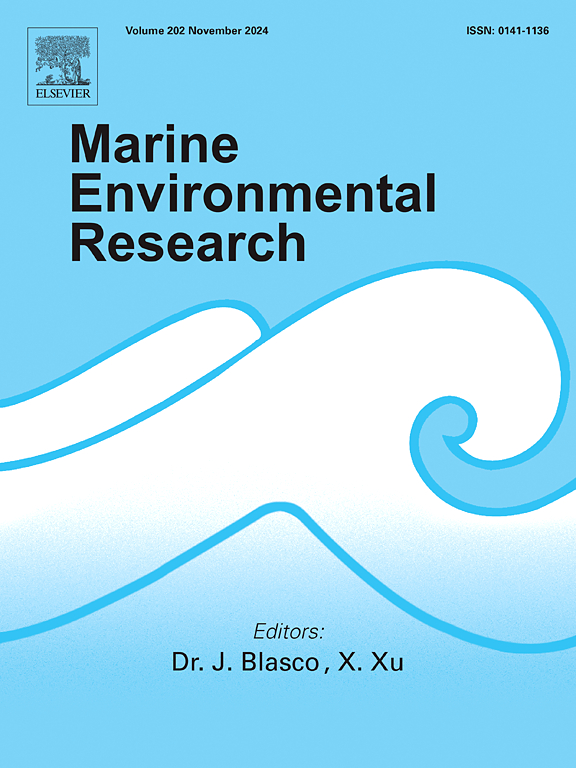Ecological links between the yellowfin tuna and an isolated archipelago in the Atlantic Ocean revealed by otolith chemistry
IF 3.2
3区 环境科学与生态学
Q2 ENVIRONMENTAL SCIENCES
引用次数: 0
Abstract
The Saint Peter and Saint Paul Archipelago (SPSPA) is a small, remote group of islands on the Mid-Atlantic Ridge that is home to many large-bodied migratory pelagic fishes. Here, we used the yellowfin tuna (Thunnus albacares) as a model species to test the hypothesis that the SPSPA hosts subpopulations originating from other regions of the Atlantic based on the otolith chemistry. Juvenile yellowfin tunas were caught in the SPSPA over a one-year cycle, and their otoliths were analyzed using LA-ICPMS. The chemical composition of the natal origin in the otoliths was investigated and subsequently compared to that of the capture site. A K-means clustering algorithm identified two clusters for the natal origin, which differed mainly in terms of the elements Mg and Cu, indicating that two subpopulations of the yellowfin tuna occur in the SPSPA. A strong, peculiar signature was found for the SPSPA capture site, with the highest concentrations of Zn, Ba and Sr. No overlap was found between the natal origins and capture site, revealing that the SPSPA was not a spawning ground for the individuals. Zinc was the most influential element in separating groups, which may be an indicator of the passage of fish by the SPSPA. Herein, we suggest that the natal origins corresponded to the Gulf of Guinea and Southern Cape Verde Islands and that the SPSPA may serve as a stopover site during Atlantic migratory routes of subpopulations of the yellowfin tuna. Mark-recapture data from ICCAT support the suggested natal origins and migratory routes addressed here. These findings demonstrate the pivotal role of the SPSPA in the lifecycle of subpopulations of the yellowfin tuna crossing the Atlantic Ocean.

耳石化学揭示了黄鳍金枪鱼和大西洋上一个孤立群岛之间的生态联系
圣彼得和圣保罗群岛(SPSPA)是大西洋中脊上一个偏远的小岛群,是许多大型洄游远洋鱼类的家园。在这里,我们使用黄鳍金枪鱼(Thunnus albacares)作为模型物种来测试SPSPA的假说,即基于耳石化学,SPSPA拥有来自大西洋其他地区的亚种群。在SPSPA以一年为周期捕获黄鳍金枪鱼幼鱼,并使用LA-ICPMS对其耳石进行分析。研究了耳石中出生来源的化学成分,并随后与捕获地点的化学成分进行了比较。通过K-means聚类算法确定了两种黄鳍金枪鱼的出生来源,它们主要在元素Mg和Cu方面存在差异,表明SPSPA中存在两个黄鳍金枪鱼亚群。在SPSPA捕获点发现了一个强烈的、特殊的特征,锌、钡和锶的浓度最高。在出生地点和捕获点之间没有发现重叠,表明SPSPA不是个体的产卵地。锌是分离组中影响最大的元素,这可能是SPSPA通过鱼类的一个指标。因此,我们认为黄鳍金枪鱼的出生地与几内亚湾和南佛得角群岛相对应,SPSPA可能是黄鳍金枪鱼亚群在大西洋迁徙路线上的中转站。ICCAT的标记重新捕获数据支持本文提出的出生起源和迁徙路线。这些发现证明了SPSPA在穿越大西洋的黄鳍金枪鱼亚群生命周期中的关键作用。
本文章由计算机程序翻译,如有差异,请以英文原文为准。
求助全文
约1分钟内获得全文
求助全文
来源期刊

Marine environmental research
环境科学-毒理学
CiteScore
5.90
自引率
3.00%
发文量
217
审稿时长
46 days
期刊介绍:
Marine Environmental Research publishes original research papers on chemical, physical, and biological interactions in the oceans and coastal waters. The journal serves as a forum for new information on biology, chemistry, and toxicology and syntheses that advance understanding of marine environmental processes.
Submission of multidisciplinary studies is encouraged. Studies that utilize experimental approaches to clarify the roles of anthropogenic and natural causes of changes in marine ecosystems are especially welcome, as are those studies that represent new developments of a theoretical or conceptual aspect of marine science. All papers published in this journal are reviewed by qualified peers prior to acceptance and publication. Examples of topics considered to be appropriate for the journal include, but are not limited to, the following:
– The extent, persistence, and consequences of change and the recovery from such change in natural marine systems
– The biochemical, physiological, and ecological consequences of contaminants to marine organisms and ecosystems
– The biogeochemistry of naturally occurring and anthropogenic substances
– Models that describe and predict the above processes
– Monitoring studies, to the extent that their results provide new information on functional processes
– Methodological papers describing improved quantitative techniques for the marine sciences.
 求助内容:
求助内容: 应助结果提醒方式:
应助结果提醒方式:


